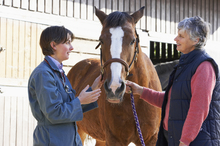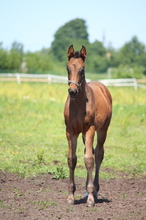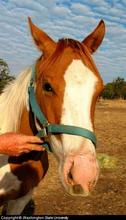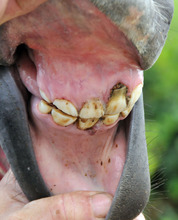Diagnosis of equine disease - skill, art and partnership

Being in the know
The responsible owner or handler works in partnership with the veterinarian by developing a range of knowledge and skills.
There's good reason for the many hours of education, lab and research work and internship required to become a veterinarian. To begin with, imagine the complexity of working with patients that do not communicate verbally. In addition, diagnosing and treating equine diseases and conditions is a complex undertaking involving both skill and art as the veterinarian works to understand the animal involved and make use of available medical resources.
The responsible owner or handler works in partnership with the veterinarian by developing a range of knowledge and skills that lead to early awareness of any changes in behavior, movement or general condition that indicates an equine health problem.
Establishing a norm for the vital signs, exercise tolerance, eating habits and general demeanor of the equine when at the "top of its game," gives an owner greater awareness of any changes occurring in the health of the horse. An observant owner or handler can act preemptively by tracking symptoms, being aware of any indications of an emergency, and knowing when to call a veterinarian.
Signs of equine disease
Changes in physical appearance, behavior or movement often indicate a change in the health of the equine and serve as a wake-up call to the owner or handler that the horse needs attention. Any time an equine exhibits one or more of the following signs, a veterinarian should be called:
- Limping or favoring one leg
- Exercise intolerance
- Lethargy
- Inability to stand
- Indications of pain in the horse's abdomen
- Labored breathing
- Swollen lymph nodes
- Straining to urinate or defecate
- Refusal to eat
- Weight loss
- Distended veins
- Swelling in any part of body or on legs
- Blood in urine
- Choking
- Bleeding or injury
- Swollen or painful eyes
Please note that these symptoms are not in any order of importance, nor is the list all-inclusive. Your veterinarian may add other conditions to the list, and it is of utmost importance that you have an ongoing conversation with your vet about what is best for your particular equine(s).
Catch symptoms early for best prognosis
Equines are susceptible to numerous infectious diseases as well as diseases and conditions that affect the major body systems. Although symptoms may vary, usually most health problems present recognizable symptoms that can lead to effective diagnosis.
In the case of infectious disease, fever is often an early symptom, along with diarrhea, colic, respiratory distress, lethargy, exercise intolerance, swollen lymph nodes, refusal to eat, weight loss and dehydration.
The equine digestive system

Changes in behavior
Any time an equine shows signs of colic, lack of appetite, unthrifty appearance or weight loss, a thorough examination and diagnosis of the problem needs to be completed by a veterinarian.
The equine digestive system is extremely complex and susceptible to upsets and a number of major diseases and conditions.
The esophagus may become blocked by choke or impaction, progressive tumors or strictures. Any time a horse coughs, regurgitates food and saliva through the nose, drools or acts nervous and makes repeated efforts to swallow by lowering its head and stretching its neck, it needs immediate attention from a veterinarian to diagnose the problem and begin treatment.
Diseases of the stomach are associated with indigestion, loss of weight and condition, diarrhea and colicky pain in the abdomen. Ulcers, gastric rupture or dilation and gastritis lead to great discomfort for the equine and laminitis may accompany or follow acute gastritis. Any time an equine shows signs of colic, lack of appetite, unthrifty appearance or weight loss, a thorough examination and diagnosis of the problem needs to be completed by a veterinarian.
The small intestine and colon of the equine are also susceptible to colic and obstruction. Enteritis, which is inflammatory disease of the small bowel, and enterocolitis, which involves the colon, are the results of infections or intestinal parasites. Colic, depression, weight loss and diarrhea are common symptoms of problems in the small intestine and colon.
Impactions are mechanical blockages that occur in the cecum or large colon and may be the result of poor feed, unchewed feed, decreased water intake, ingestion of sand or heavy parasite infestation. Colic, apathy, loss of appetite, increased thirst and passage of small amounts of hard manure covered by mucus are signs of impaction. Identifying and correcting the cause to prevent recurrence, along with relieving the impaction, are best done by a veterinarian.
Other concerns related to the equine digestive system include strangulation of the intestines, peritonitis, liver diseases, acute diarrhea and constipation. The symptoms to watch for include colic, sudden severe pain in abdomen, swelling, sweating, jaundice, loss of appetite, lethargy, profuse explosive foul-smelling manure or small amounts of dry, hard manure. Any of these conditions may be life-threatening and the veterinarian should be called immediately.
The equine respiratory system

Winded without working
Fever, nasal and eye discharge, exercise intolerance, loss of appetite and weight, colic symptoms, are also symptoms of respiratory distress.
The upper part of the equine respiratory system is lined by a delicate membrane covered by a layer of mucus that traps bacteria and foreign irritants and acts as a first line of defense against infection. This layer of mucus is moved by cilia toward the front of the nose, enabling the respiratory system to rid itself of the potentially damaging bacteria or substances.
Although a clear nasal discharge is common, nasal discharge is often a sign of disease in the respiratory system. A thick, yellow mucopurulent discharge from both nostrils indicates a bacterial or fungus infection. When the discharge is from one nostril, sinusitis, guttural pouch mycocis, a foreign body, polyp or tumor may be causing the problem.
Sore throats in equines are associated with respiratory infections such as strangles, rhinopneumonitis and influenza. A purulent discharge, along with fever, noisy respiration, coughing, gagging, pain in the throat and loss of appetite often accompany these conditions.
Symptoms of diseases of the lower respiratory system include rapid, noisy or shallow breathing, wheezing, crackling and bubbling sounds over the lungs and coughing. Acute bronchitis, chronic obstructive pulmonary disease, also known as heaves or (COPD), pneumonia, pleuritis and pleuopneumonia are diseases that affect the lower respiratory system.
In addition to breathing problems, symptoms that indicate respiratory infections or conditions include fever, nasal and eye discharge, exercise intolerance, loss of appetite and weight, and colic symptoms.
Any time symptoms of respiratory problems are noticed, a veterinarian should be called to diagnose and treat the disease.
The equine circulatory system

Monitor heart rates
A horse's heart rate can be determined with a stethoscope, placed just behind the left elbow.
The equine circulatory system consists of the heart, the blood, and the blood vessels, including the veins and arteries. Certain physical signs help to determine whether a horse's heart and circulation are working properly. Establishing a baseline for the healthy horse's pulse, capillary refill time, and any swelling on the horse's body or limbs is important for ongoing comparisons that may indicate a change from a healthy circulatory system to a less-than-healthy state.
Heart disease affects horses of all ages and breeds. Foals should be checked to make sure they do not have a congenital heart defect. The most common abnormalities affect the valves and muscle of the heart. Cardiac problems may manifest in exercise intolerance, irregular heartbeat, poor growth, weakness, distended veins, edema and collapse.
In the mature equine, diseases and conditions of the circulatory system include heart failure, thrombophlebitis, arterial vascular disease, anemia, valvular heart disease, bacterial endocarditis, pericarditis, myocarditis and cardiomyopathy, among others.
Common symptoms of circulatory system failure include lethargy, loss of appetite and weight, muscular weakness, rapid, heavy breathing, exercise intolerance and, in serious cases, collapse of the horse.
Although an owner can recognize early signs of cardiac problems, diagnosis and treatment by a veterinarian are essential. The use of electrocardiograms, x-rays, echocardiography and access to the latest drugs are essential when an equine's circulatory system begins to breakdown or fail.
The equine nervous system

Unusual movement
When nervous system disease or damage is suspected, a veterinarian should be called to diagnose and treat the disease or condition in its earliest stages.
The central nervous system of the horse includes the cerebrum, cerebellum, cranial nerves and brainstem and the spinal cord. Memory, behavior, voluntary motor control, balance, coordination of movements, consciousness, respiratory and heart rate, blood pressure, bladder and bowel control and the sending of motor impulses to muscles are all products of the equine nervous system.
Any disease or damage to the nervous system may have serious consequences for the horse. Typical symptoms of diseases and conditions affecting the nervous system include seizures, depression, changes in personality and behavior, incoordination, changes in gait, muscle tremors, changes in body temperature or hormone systems, loss of sensation and loss of bladder and bowel control.
In addition, diseases or damage affecting the cranial nerves can lead to varying degrees of blindness, loss of control of facial muscles and difficulty in swallowing.
Brain and spinal cord infections or damage may result in encephalitis, myeloencephalitis, equine degenerative myeloencephalopathy, meningitis and seizures.
In all cases when nervous system disease or damage is suspected, a veterinarian should be called to diagnose and treat the disease or condition in its earliest stages.
The equine musculoskeletal system

Recognizing early symptoms
Physitis involves swelling around the growth plates of certain long bones in young horses.
The equine bone structure consists of approximately 216 individual bones connected by ligaments and surrounded by muscles. The bones are covered by a layer of dense connective tissue known as the periosteum, and the bones are joined together by ligaments, tendons and the synovial membrane that secretes fluid and allows for friction-free movement. Interspersed between the tendons and bones are fluid-filled sacs known as bursae. Because horses are athletic animals, injuries to the musculoskeletal structures are common.
Lameness and gait disturbances are common indications that problems have developed in the limbs or the foot of the horse. Sudden onset of lameness indicates laminitis or an acute injury.
When a horse appears lame, each foot should be examined carefully for possible puncture wounds, a bruised sole or corn. A hoof tester is used to examine the foot for wounds, laminitis, gravel, quittor or navicular disease. If the front feet are hot, founder is a possibility. Swelling of the foot above the coronet may indicate ringbone.
Swelling of joints, pain and increased warmth indicate inflammation either from an injury or a disease. Painful swelling along the inside front of the cannon bone indicates bucked shins or splint, and swelling without pain suggests tenosynovitis or bursitis.
Musculoskeletal injuries and diseases affect the tendons and the ligaments and include stringhalt and bursitis. Sprains and strains are common problems in the joints. Periostitis is an inflammation of the connective tissue and may lead to unwanted new bone formation.
Developmental orthopedic diseases (DOD) affect many equines. Among these are osteochondrosis, dysplasia, knock knees, bow legs and bucked or sprung knees.
Other joint ailments include arthritis, bone spavin and osselets.
In addition, horses are susceptible to fractures and broken bones in all areas of the limbs and the body structure.
Muscle strains and diseases or other problems in the musculoskeletal system plague some horses. Stiffness, dragging hind toes, gait alterations and warm, painful muscles are common symptoms. Navicular disease is a common cause of front leg lameness in horses. A stiff, shuffling gait with a shortened, choppy stride is symptomatic of navicular disease.
Fortunately, a veterinarian has a number of ways of diagnosing the cause of a problem in the musculoskeletal system, including x-rays, ultrasonography, bone scans, nerve blocks, synovial fluid analysis and arthroscopy. Early diagnosis and treatment often prevents ongoing problems, so prompt attention from a veterinarian is important in both diagnosing and treating musculoskeletal problems.
The equine urinary system
The equine urinary system is composed of the kidneys, ureters, bladder and uretha. Normally, equine urine is cloudy, strong, alkaline and rather mucoid. Fresh urine that is dark and coffee-colored suggests the presence of myoglobin, seen in tying-up syndrome (azoturia); presence of hemoglobin in the urine occurs in hemolytic anemia and the presence of bile is an indication of jaundice.
Blood in the urine may be an indication of either cystitis or urinary tract stones. Polyuria, which is the passage of unusually large amounts of urine, may indicate chronic kidney failure. The bladder capacity of an adult horse is approximately 1 gallon. Extreme thirst and continual drinking of water are other indications of polyuria.
Painful urination and straining to urinate are known as dysuria and are indications of a lower urinary tract infection such as cystitus, urethritis and bladder stones. Blister beetle poisoning is an unusual cause of dysuria.
Kidney diseases related to kidney failure include glomerulonephritis, interstitial nephritis and nephrosis. When the kidneys fail to remove nitrogen and other wastes from the blood, the build-up of toxic chemicals produces signs and symptoms of uremic poisoning, including severe depression, loss of appetite, weight loss, anemia, ammonia-like odor on the breath, excessive tartar build up on teeth and eventually coma.
In cases of suspected urinary system disease or failure, a veterinarian should be called to diagnose the problem and prescribe treatment.
Skin - the equine integumentary system

Sunburn
The treatment for a sunburned horse is pretty similar to that of the sunburn treatment for humans: frequent applications of pure aloe can soothe the sunburned horse's skin immensely.
© Washington State University
Although the skin of an equine is remarkably strong, it is also sensitive. As the barrier that keeps bacteria and other foreign agents out of the tissues and bloodstream of the equine, it also gives form to the body, insulates the horse against cold and heat, provides sensations to the surface of the body and is involved in the synthesis of vitamins.
The skin of the equine can be easily damaged by tack, rough handling, injury, insects or parasites and skin disorders. Itchy skin disorders caused by insect bites, allergies, worms and worm larvae and fungus cause discomfort and make the horse susceptible to additional infections and irritants.
Skin infections include abscesses, cellulitis, folliculitis, rain scalds, grease heel, summer sores and various forms of dermatitis. Pus, discharge, swelling, heat, patches of matted hair, draining sores or ulcers and crusty patches are some indications of skin infection.
Horses are also susceptible to warts, sarcoid tumors, squamous cell carcinoma, melanoma, lymphosarcoma and infestations of cattle grubs. These conditions are evidenced by lumps, bumps and growths on or beneath the skin and examination will determine whether they are benign or need immediate treatment. Early diagnosis is important.
Anhydrosis, the absence of sweating, often occurs during hot weather when the humidity is high. A rapid pulse, high fever, dry skin and rapid labored breathing are typical symptoms of this condition.
Allergies caused by a foreign protein that invades the horse's immune system may trigger the release of histamine, resulting in hives, which are raised bumps that may or may not itch. Contact dermatitis, caused by an allergic reaction to a chemical, results in itchy, red bumps and fluid-filled blisters.
Saddle sores, rope burns and galls are the consequence of skin injuries caused by ill-fitting or careless use of tack. Usually the sores and cause are self-evident.
Once a diagnosis is made by a veterinarian, many skin diseases and conditions can be treated effectively by the owner or handler using the medication prescribed by the veterinarian.
The equine eyes

Eye injuries
Prompt attention by a veterinarian to diagnose and treat any equine eye problem is extremely important. Early intervention can often save the horse's eyesight
Fortunately, eye injuries are not common in the equine, partly because of the heavy framework of bone that surrounds the eye and because of the way the eyeball is situated and protected by the eyelid structure and muscles surrounding the eye.
Pain and change in appearance are the most common indications of an eye problem in an equine. Excessive tearing, squinting, tenderness to touch and avoidance of light may be the result of injury to the cornea or a disorder such as uveitis.
Any indication of pain in a horse's eye should be immediately reported to the veterinarian. Eye damage in horses progresses rather quickly and may be associated with loss of vision if not diagnosed and treated promptly.
Eye discharge, red or cloudy eyes, a film over the front of the eye or a bulging or sunken eye are symptoms of eye disorders or injuries. In addition, conjunctivitis and inflamed or puffy eyelids indicate infection or infestation by larvae and need prompt attention.
Uveitis, also known as moon blindness, is an inflammation of the uveal tract, which is composed of the inner pigmented structures of the eye. Uveitis is one of the most common disorders of the eye and is the leading cause of blindness. Painful, red eyes that squint and tear are early indicators of uveitis. In addition, the eye may appear cloudy, have a contracted pupil and a tender, soft-feeling eyeball.
Equines are also susceptible to cataracts, glaucoma, retinal diseases and retinal detachment. Changes in the eyeball, tenderness, night blindness and a bluish haze are symptoms of these eye conditions.
The eyelids and nictitating membrane are sometimes prone to benign and malignant tumors, including squamous cell carcinoma, sarcoids, melanomas, skin papillomas and lymphosarcomas. Any growths in the eye area should be diagnosed and removed at the earliest possible stage.
Prompt attention by a veterinarian to diagnose and treat any equine eye problem is extremely important. Early intervention can often save the horse's eyesight, as well as prevent discomfort and possible injury.
The equine ears

Unclipped
Leaving a horse's ears unclipped during warmer months will help fend off biting insects.
© April Raine | EquiDesis, LLC.
Horses have a well-developed sense of hearing along with an auditory mechanism that picks up vibrations tramsmitted through the ground and conveys that information to the middle ear through the jawbone. A horse's ability to hear can be judged by how it uses its ears. Since a horse that hears well rotates its ears toward the source of a sound, lack of attentiveness and quiet ears are two indications that the horse doesn't hear as well as it should.
The ear flap of the horse is subject to fly-bite dermatitis, tumors, plaques and lacerations. Ear ticks can travel into the ear canal and occasional ear infections may occur. Head shaking, tenderness to touch, redness and swelling of the ear fold, a bad odor or a purulent ear discharge indicate a problem in the ear canal.
Bacterial infection of the middle and inner ear can result in labyrinthitis, which results in dizziness, incoordination, loss of balance, a staggering gait and a tendency to lean against walls or fences for support.
Again, a veterinarian is trained to diagnose and treat any problem with an equine's ears, whether it relates to hearing or to a disease or injury.
The equine oral cavity

Baby teeth
Deciduous (baby) teeth can be so firmly lodged that the underlying permanent teeth become impacted. Food lodges in between causing discomfort and infection.
© April Raine | EquiDesis, LLC.
An equine's mouth, teeth, lips, tongue, palate, throat and soft tissue of the face and neck tell a great deal about the horse. Pale gums are a possible sign of parasites or anemia; bluish-gray gums indicate low oxygen caused by respiratory or circulatory failure. Yellow gums indicate jaundice.
The horse's mouth is susceptible to cuts and tongue lacerations, as well as to penetration by foreign bodies, such as splinters, burrs, foxtail and other irritating substances that may become embedded in the tissues and on the surface of the tongue.
Infected teeth, viral infectious diseases, photosensitivity reactions and prolonged use of medications can affect the health of the equine oral cavity. Although tumors in the mouth are not common, growths that ulcerate and exude a bad odor may be malignant. Squamous cell carcinoma is the most common, and other malignant tumors include melanoma, fibrosarcoma and lymphoma.
Benign tumors that occur in and around the mouth include sarcoids, papillomas, cysts, neoplams and granulomas.
Common problems with teeth include dental caps, impacted teeth, wolf teeth, hooks and split or broken teeth. Abnormal wear patterns are common, and having the teeth and oral cavity checked on a regular basis and the teeth floated by a veterinarian is very important.
Although this article touches on many aspects of various equine diseases and conditions, it is in no way comprehensive. Your best source for proper diagnosis and treatment of any health problem is your veterinarian. Informed and observant equine owners and handlers are valuable partners in communicating changes that may indicate signs of injury or health concerns, allowing for prompt veterinary response and positive outcomes.

